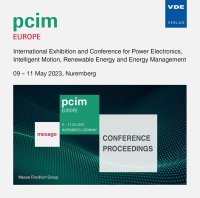Advanced Synchronous Rectification for an IGBT-Based ZCS LLC Converter with High Output Currents for a 2 kW Automotive DC-DC Stage
Conference: PCIM Europe 2023 - International Exhibition and Conference for Power Electronics, Intelligent Motion, Renewable Energy and Energy Management
05/09/2023 - 05/11/2023 at Nürnberg, Germany
doi:10.30420/566091239
Proceedings: PCIM Europe 2023
Pages: 9Language: englishTyp: PDF
Authors:
Urbaneck, Daniel; Schafmeister, Frank; Boecker, Joachim (Paderborn University, Paderborn, Germany)
Abstract:
State-of-the-art LLC resonant converters use MOSFETs in their inverter stage, which allows high switching frequencies and thus the use of compact magnetic components. The large parasitic output capacitance and the poor reverse-recovery behaviour of the inherent body diode of high-voltage (600 V) silicon MOSFETs require soft switching, i.e. zero-voltage switching (ZVS). Otherwise, the high turn-on switching losses would lead to excessive heating and ultimately to the destruction of the switch. Therefore, MOSFET-based LLC converters are operated in the so-called inductive region only, which enables ZVS. The use of robust and cost-effective IGBTs instead of MOSFETs is particularly advantageous for automotive applications, since in addition to high reliability low costs are an important objective here. Since IGBTs are characterized by dominant turn-off losses and generally higher switching losses compared to MOSFETs, the aim is to operate them with zero-current switching (ZCS) and at low switching frequencies below the resonance frequency. In this region also the voltage transfer characteristic is steeper, which qualifies for applications with a strongly varying input-to-output voltage ratio, such as given for automotive on-board DC-DC converters connecting the (high-voltage) traction battery with the (12 V) auxiliary battery. In this paper, a stress value analysis based on a switched-model simulation is used to design a ZCS LLC converter and take advantage of the mentioned benefits of IGBTs as well as of the steeper voltage transfer characteristic. Within this operation region below the resonance frequency, however, a new phenomenon of several current pulses occurring during a single switching period through the rectifier components may appear. Generally, in applications with high output currents a synchronous rectifier (SR) is often used to keep the conduction losses of the rectifier stage at a moderate level: Low-voltage MOSFETs, which actively need to be gated synchronously to the polarity of the current pulses, are employed then instead of more lossy rectifier diodes. However, standard SR driver ICs have been shown to be unable to properly rectify the multi-pulse output currents of the proposed LLC operation, resulting in high conduction losses of the rectifier stage. A cost-effective hardware concept is presented which ensures proper rectification by using standard SR-ICs that are actively overdriven by the converter’s central microcontroller. A 2 kW prototype for an EV on-board DCDC converter was built to show the effectiveness of the method, documenting an increase in efficiency by up to 4.1 % compared to a purely SR-IC-based solution. Overall efficiency is very similar to that of a conventional (MOSFET-based) LLC converter so that the ZCS-operated LLC IGBT-converter represents a cost-effective alternative, which even shows 10 % less worst-case losses.


